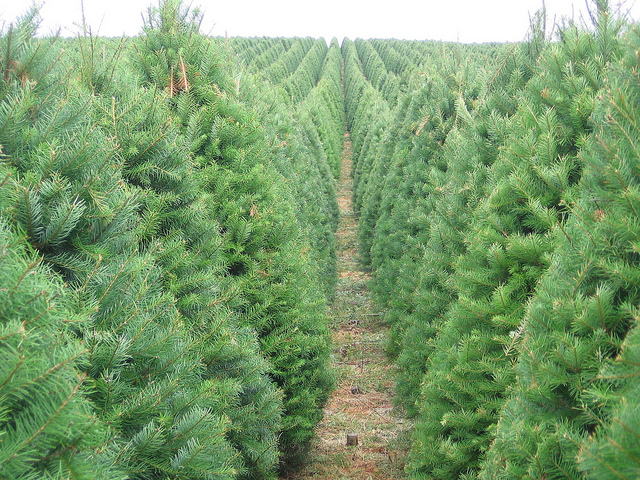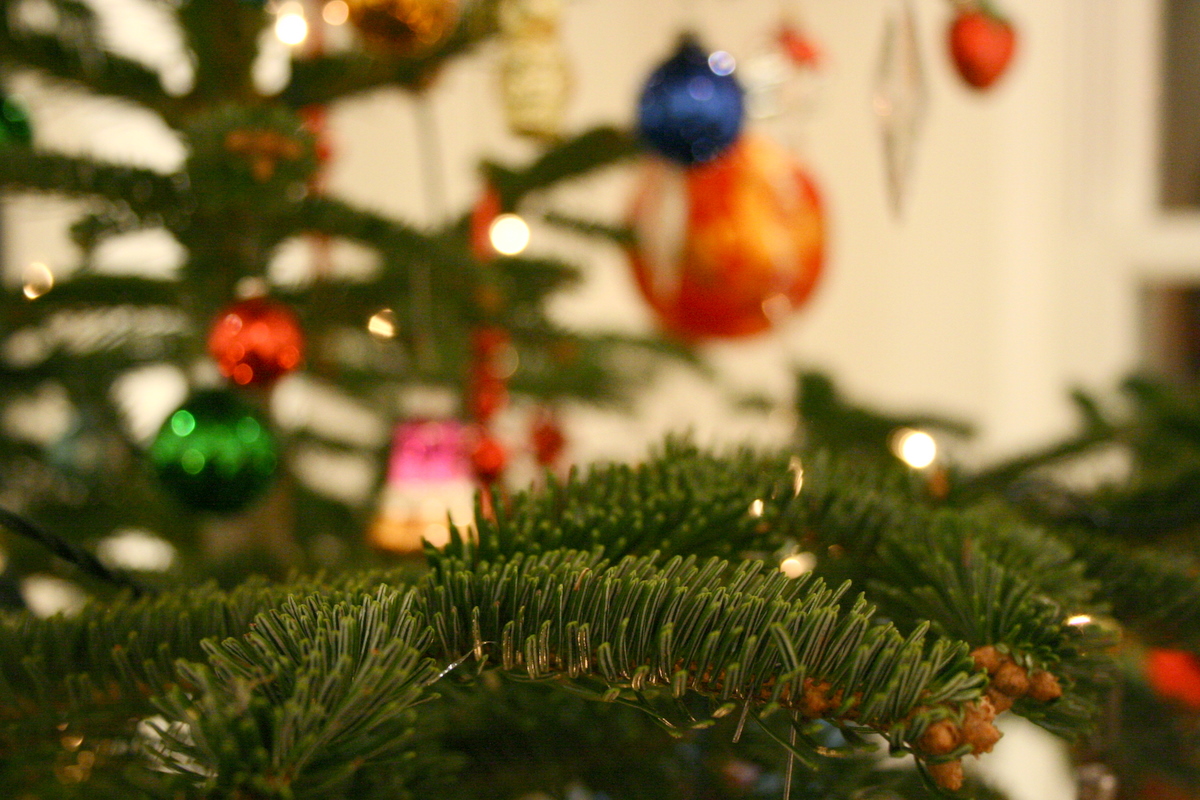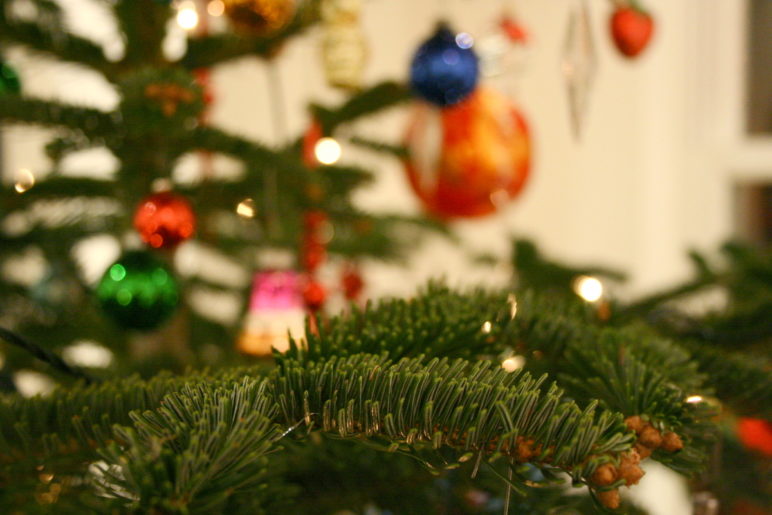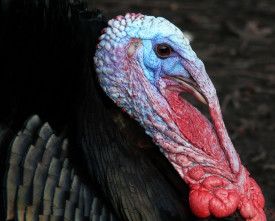Editor’s Note December 2022: Thinking about buying a Christmas tree? We’re bringing back this popular post weighing in on the great debate: pine vs. plastic, which tree is the better option for the planet? And if you decide to go for the ultimate sustainable option this year, check out our ten DIY trees that reuse and recycle.
Cascadia is a global center of Christmas tree farming, harvesting approximately nine million trees per year.
Cascadia is a global center of Christmas tree farming, harvesting approximately nine million trees per year. Christmas tree farms pepper the region’s landscape, covering nearly 100,000 acres across British Columbia, Oregon (the top Christmas tree-producing state in the United States), and Washington (the fifth-largest producer). Together, these farms may store more than 80,000 tons of CO2 annually, roughly equal to the emissions produced by 17,000 cars in a year.
But is fresh-cut the greener choice? Or are reusable plastic trees, like most reusable goods, the better option? Short answer: with rare exceptions, real trees are better, at least when measured by their climate impact. Here’s a look at some of the biggest sources of greenhouse pollution in the four phases of a tree’s life—production, transport, use, and disposal—based mostly on analyses conducted by Montreal-based consulting firm Ellipsos in 2009 and PE International in 2010.
Production
Manufacturing accounts for nearly 70 percent of total greenhouse gas pollution released during a fake tree’s lifetime (see this report, p. 53). Manufacturers fashion fake trees mostly out of two energy-intensive materials: steel and polyvinyl chloride (PVC), a versatile plastic with an especially polluting production phase.
In contrast, as natural conifers grow, they soak up carbon from the atmosphere and store it in the soil and their cells. Though estimates vary significantly, growing Christmas trees may sequester nearly one ton of carbon dioxide per acre (see page 8), depending on the type of tree, growing conditions, and a host of other factors. Although each tree releases a portion of this gas at the end of its life as it decomposes or burns, the new crop of replacement trees absorbs a similar amount of carbon.

Christmas Tree Farm by Oregon Dept of Agriculture used under CC BY-NC-ND 2.0
Transportation
The tree in your living room probably traveled a long way to get to you, accounting for another portion of its carbon footprint.
If you have an artificial tree, it—like 80 percent of artificial trees—probably traveled 1) by truck from a factory in China to a port, 2) across the Pacific Ocean on a container ship, 3) on another truck to your local big-box store, before 4) you finally drove it home. All told, the tree crossed more than 8,400 miles (p. 31), emitting approximately 9 pounds of CO2 (p. 53), equivalent to driving a car more than 10 miles.
If the tree in your living room is natural, on the other hand, it likely journeyed far fewer miles than its fabricated counterpart. The typical US tree travels approximately 230 miles (p. 47) from 1) the site of seed production to 2) the nursery to 3) the farm to 4) the retailer and finally, 5) to a customer’s home. If you’re typical, you drove between five and seven miles to pick out your tree and bring it home (p. 31); yet these miles account for as much as 50 percent (p. 24) of your natural tree’s total carbon footprint, according to Ellipsos. Up until that point, your tree traveled with a pack of its peers, making transportation far more efficient than during those last few miles when it was just you, your car, and your tree.
The distance you drive to buy your natural tree is a main determinant in whether your tree is a net sink or source for greenhouse gas pollution over its lifespan. If the trip from home to retailer and back is ten miles or fewer, the tree can act as a net sink of greenhouse gases, according to PE International (p. 77). Beyond ten miles, it becomes a net source of emissions but may still have a smaller footprint than an artificial tree, depending on the rest of its lifecycle.
More tips on reducing your carbon footprint in our series: My Year of Nothing New
Lifespan
The number of years you will reuse a plastic tree is another factor to consider when deciding whether to go natural or fabricated. Here’s why: the high environmental cost to produce and transport the artificial tree can be spread out over all the years it’s used, so long as it replaces a natural tree each holiday season.
If you drive a fairly standard 6 miles roundtrip to purchase an artificial Christmas tree, you need to use the tree for about 20 years to break even with the climate impact of 20 fresh evergreens, according to Ellipsos (p. 48), which assumes modest vehicle emissions per mile (see more in Notes below). The fake tree may break even with its rival a little sooner—somewhere around 12 years—if Ellipsos’s figures are too cautious and EPA’s higher car emissions estimate is correct. Either way, in North America, artificial trees typically see only six Christmases before hitting the waste heap (p. 5), far too few to make them the more climate-savvy option.
Disposal

13th day of Christmas by Carrie Cizauskas used under CC BY-NC-ND 2.0
Finally, the disposal method of your Christmas tree influences its ecological impact. Though recyclers accept many components of a prefabricated tree (such as PVC and steel), most parts of Canada and the United States lack the infrastructure to separate these materials (p. 30). More than likely, when you get rid of your artificial tree, it will end up in a landfill. En route to the dump, the garbage truck will pump out more carbon.

Christmas captives by Jim Handcock used under CC BY-ND 2.0
Composting a natural tree, or turning it into wood chips, makes the best sense from a greenhouse gas and nutrient perspective. Luckily, Portland, Seattle, and Vancouver, BC, all make it easy to compost your tree. Municipal solid waste haulers in all three cities collect residents’ used trees (so long as they’re cut into lengths of six feet or less) along with household yard waste in the two weeks following the holiday. Lots of other localities across Cascadia offer similar services, including King County, Portland Metro, and Metro Vancouver. (If you have disposal tips and links for other Cascadia locales, please add them in the comments!)
So, real or fake?
Usually, real evergreens are the greener Christmas trees. Cradle to grave, Ellipsos finds that an artificial tree decorated for six holidays before it’s tossed is responsible for nearly three times more greenhouse gas pollution than six trees fresh cut and composted (p. 6). Exceptions include if the tree farm that grew your tree replaced native forest, if you get a used artificial tree close to home, and if you keep your fake tree for at least two decades. In these cases, you’d do better to go plastic.
And of course, your choice of Tannenbaum certainly is not the most climate significant choice you will make this season. All told, your tree has a climate impact equivalent to driving roughly between 10 and 20 miles. So, bike to work a few days a year, and you’ve already offset your tree, no matter which type it is. Still, considering the rapidly growing popularity of artificial trees, this is one decision that is easy to make a little greener.
Of course, the best option of all may be to try something slightly less traditional. The internet is filled with clever DIY tree alternatives, many of which use handmade or reclaimed materials. (If you have a good one, send us a photo!) In a season when it’s easy to gripe about uninhibited consumption, why not make our trees a sign of living differently?
NOTES ON METHODS AND SOURCES
Though I’ve tried to employ the most likely estimates of emissions where possible, studies vary significantly regarding the range of carbon dioxide impacts from many of the processes described in this article, resulting in a wide margin of error for many of the estimates presented here. Here are some of the largest sources of margin of error present in these calculations.
Studies vary significantly regarding CO2 sequestration on Christmas tree farms, ranging from a sequestration rate of 1.2 t of CO2 per acre to emitting as much as 0.2 tons of CO2 per acre annually (p. 43). Not surprisingly, this range makes all the difference. At the high end, with tree farms sequestering over a ton of CO2 per acre, a natural tree will always be a better choice from a climate perspective than a fake one. On the other hand, if conifer plantations work as sources of greenhouse gases, artificial trees will always be the better climate choice. I found no good data on this topic specific to Cascadian tree farms, and I assumed that Cascadian tree farms fall in the middle of the range, absorbing 0.8 tons of CO2 per acre per year. This assumption is a potential source of error in my analysis. I welcome input from experts on Northwest forest carbon flux.
Another important factor not considered by either lifecycle analysis cited here is what Christmas tree farm land may have been used for had it not been for the tree farm. There are a number of variables that make this hard to predict. As a result, this consideration has been left out of the analysis. Nevertheless, alterative land uses could result in significantly different carbon emissions or sequestration rates.
Thirdly, this analysis likely underestimates transportation emissions. Ellipsos’ assumption of CO2 emitted per mile by a standard car (p.8) is equivalent to only two-thirds of EPA’s 2014 estimate of gasoline emissions from a standard car: 411g CO2 per mile. (PE International’s car emissions estimate tracks closely with EPA’s.) Previous Sightline research suggests that even EPA’s figures may understate carbon pollution from gasoline by nearly one-third because they ignore releases of pollution “upstream” in the fossil-fuel extraction, refining, and transportation processes. For the purposes of this analysis, however, I relied largely on EPA’s 2014 estimate whenever possible. This includes any statement in which I put process emissions into context by comparing with car miles driven. I was not able, however, to incorporate EPA’s estimates into most parts of the Ellipsos study’s calculations; thus I have noted specifically when a transportation emissions estimate is based explicitly on a calculation from this lifecycle analysis. The estimate of overall climate impact of a Christmas tree presented at the end of this article (between 10 and 20 miles of driving) is based on the Ellipsos basic global warming potential calculations for natural and artificial trees (p. 8), contextualized into a driving mile equivalent using EPA’s 2014 driving emissions estimates.
Finally, I would like to note that the PE International study was commissioned by the American Christmas Tree Association (ACTA), an industry association for artificial tree manufacturers. The Ellipsos study was not commissioned by a client but was done for publicity and internal training purposes (private email communication from Ellipsos, December 18, 2015).












Donangelo
I don’t understand why anyone would want to murder a tree and put the corpse in their living room to celebrate the return of life, everlasting life, the man who told us he was bringing not peace but the sword, which he did, or anything else. If you insist, decorate a tree in your yard and stop this barbarian nonsense! If we do not love our Mother Earth in all her forms, we will destroy ourselves.
Jami Warner
The PE International study commissioned by the American Christmas Tree Association was the first peer-reviewed Life Cycle Analysis ever that compared the average real Christmas tree to the average artificial tree. The conclusions of both the Ellipsos study and the PE International Life Cycle Analysis were virtually the same–both the real and the artificial tree have a negligible impact on the environment, especially when compared with something we all do every day, such as drive a car. The choice of a Christmas tree is a personal choice, not a moral choice. Please relax and enjoy your Christmas tree, whichever kind you choose. Merry Christmas.
Uncle Chris
In part, my sentiments lie with Ms. Warner’s, and her’s seem to align with the author’s. Compared to many other activities, those surrounding the manufacturing, harvesting, transportation, use and disposal of Christmas trees, real or fake, doesn’t appear to be “most climate significant choice” to be made, as the author indicates.
Not that either the author or this site are guilty of focusing on the trivial to avoid the significant, however, doing so lessens the credibility of the overall cause while ensuring that little good can be produced.
For example, each year approximately 5,500 blacks are killed by gunfire and 94% of all such homicides are committed by other blacks. Approximately 600 persons are killed each year by police officers, independent of the race of either the victim or the officer. The “Black Lives Matter” movement seems not only racially named, but solely focused on police on black killings.
If black lives really matter, then why ignore 5,500 black deaths in favor of a focus on what must be less than 600 deaths? If “Black Lives Matter” was so incredibly successful that it eliminated every black death by police officers, then wouldn’t that still leave 5,500 black deaths per year by non-policepersons?
hayley burke
I only found this discussion today so i’m way late! LOL! However, i feel very strongly about this discussion. Both Christmas trees are having a massive negative impact on our environment. Real trees – why doesn’t anyone ever talk about the fact that 99% of Christmas tree farms use monoculture and spray pesticides, insecticides etc which are seriously harming wildlife, killing our soils and contaminating our waterways! I wouldn’t say that’s negligible. Artificial Christmas trees since the beginning of the Christmas tree sustainability debate have always been made using the cradle to grave method, meaning they are not at all recyclable. Making products to eventually end up in landfill or incinerator is not taking responsibility. They also contain cheap and inappropriate chemical additives like Antimony trioxide!
Frana
Another option is to use a ‘living tree’, which Swanson’s Nursery offers. It works like this: you pick out your tree, take it home and enjoy it during the holiday season, and return it to the nursery after the holidays. Swanson’s partners with King County Parks and Seattle Parks to make sure the tree is planted in a local restoration project and can live out the rest of its life happy and evergreen in a local forest. Read more here.
Margaret Morales
Great! Do you know of any other living tree options in the rest of Cascadia?
Kristin Eberhard
If you are in Portland you can get a living tree here that gets planted back in the Christmas tree farm and re-used every year. The best of both worlds: live tree + re-use!
hayley burke
i love this idea. I read that there is a high so called ‘death rate’ as american homes are often heated to pretty warm temperatures. Do you have any figures on this? Thanks 🙂
Raelene Gild
I just have a small DouglasFir in a large pot and bring it inside to decorate each year, and return it to the porch after the holidays until next year. It’s simple.
Serena Larkin
Growing up with a fake tree, I never really knew I was missing anything aside from the mess of pine needles I experienced at friends’ homes. And our tree must be nearly 40 years old at this point, because my mom recently told me we actually inherited it from my grandma’s house. Ha! We bag it and store it each year, with a transportation distance of no more than from the downstairs level up to the attic—by foot, of course!
hayley burke
I love stories like this. However, if your tree is that old it’s almost certainly going to contain lead as a stabiliser. Please make sure you vacuum often around the tree and keep small children and pets away 🙂
Berkeley Bush
I’m not going to feel guilty over a Christmas tree. Locally, the living trees are recycled. The Boy Scouts take them and recycle them. The city waste management takes them to be recycled by the Boy Scouts. The local news media does stories on it every year. This is a major metropolitan area.
As for the artificial trees, well, the last one I had was used for over 25 years. I would still be using it, but my wife donated it to someone who needed it. They are still using it.
The replacement trees that we have came from our family business. They have been in use almost as long (over 20 years) and will be used for many, many more years to come. So, I would say that over time I actually have a negative carbon footprint from Christmas trees.
See, if you’re responsible, then you can be guilt-free and environmentally friendly (not to mention cost-effective).
So, what’s the carbon footprint of this magazine and of publishing this article?
hayley burke
I love that the boy scouts recycle the trees and that they get well deserved local publicity. And of course, yes they are totally recyclable too. At the moment I believe they are the better choice of tree (apart from one in a pot that you can reuse year after year). What I don’t agree with is the amount of chemicals that are used in the monoculture environments which 99% of Christmas tree are grown in. These chemicals are not only damaging to wildlife but also it’s killing our soils getting into our waterways and entering the food chain, and finally into you (if you eat meat or fish). we’re also living at a time where we need to keep as many trees as possible in the ground to help soak up our increasing amount of CO2 levels. So to cut down a tree that has grown between 8 and 10 years to decorate our home with it for a few weeks, seems a bit of a waste to say the least. I’m working on solving this debate.
bstano
How much of a carbon footprint is calculated when you drive a truck in the mountains for several hours looking for the perfect tree, when you spot it you fire up your chainsaw, cut it, sit by a fire for awhile, then drive your lovely new tree home?
SSBluRidge
Actually, pretty unnecessary to use a chain saw, under 5 minutes with a hand saw since something under 10 feet tall has a pretty thin trunk. We get them from our local tree farmer, thus supporting a small local family business. They prune and shape them (with hand pruners) all year round for several years, so they get that full bushy look. I don’t think it’s any different than cutting flowers that I grow out here for a vase, or buying stuff from the farmer’s market. I suppose it’s possible to factory farm trees, but that’s not the only way to get them.
Uncle Chris
Don’t the real trees also contribute to a carbon footprint because they need fertilizer, pumped irrigation water, cultivation with a tractor, harvesting chain saws, and loading by fork lift or HELICOPTER (true!)?
Perhaps this was considered in some of the analyses that I did not read.
hayley
Hmmmm, monoculture, pesticides, insecticides is also not taken into account! Poisoning the planet is never a good idea!
Tani Mann
How about a second-hand artificial one?
hayley burke
I love to hear of people who use pre-loved things! I think the idea of using a second hand tree is theoretically good, as long as it’s not too old, because if it’s the old PVC kind (which it probably is) it will contain lead as a stabilizer. Just be sure to clean around the tree every day and don’t let small kids and animals play near the tree. 🙂
Onesmus Mwangi Mulima
I love this idear, it’s better to use the during holidays season and return it to the porch after holidays until the next time holidays to come.
Enid
Comparing the carbon footprint of a live tree vs. an artificial one is a logical fallacy, as there is an ideal option to either selection: no tree at all. Once you remove artificial trees from this artificial equation it becomes clear that the cutting of live trees for brief decorative purposes is unsustainable and highly detrimental to the environment. As an alternative, many conifers benefit from a seasonal pruning, and the scented foliage can be used in lovely, natural decorations. There are also bare-wood trees available that have been constructed from pruned or recycled wood that can be adorned with the usual ornaments. As a retired arborist/horticulturist I can also tell you that Christmas trees are saturated with fungicides and pesticides. The reason is that customers tend to freak out when spiders and insects emerge en masse in their living rooms from the conifers that provide winter retreats deep in the foliage. This is neither safe for the planet nor people and/or pets in an enclosed space.